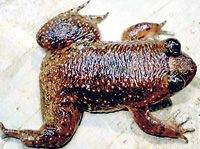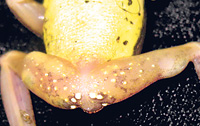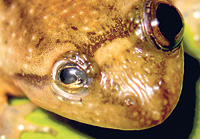Amphibians are under attack not only around the world but right here in Sri Lanka which is considered a “global hotspot” for such creatures as the humble toad and simple frog.
Malformations, trauma, eye infections and abnormalities, possible amphibian tuberculosis, parasitic infections, possible microbial infections and insect attacks……..you name it amphibians are falling prey to it, all over the world as well as at an alarming rate in Sri Lanka.
 |
| Anslem de Silva |
These are not only the startling but also the disturbing findings of the first island-wide Survey on ‘Malformations, injuries and parasitic infections in frogs, toads and caecilians of Sri Lanka’, carried out by none other than leading herpetologist Anslem de Silva, famous as the country’s “snake man” and his team. Sri Lanka has about 106 species of amphibians and many more are in the process of being named, forming the highest endemics (85%) among vertebrates.
Both ‘EDGE’ species endemic to Sri Lanka -- Nannophrys marmorata (Kirtisinghe's rock frog or Kirtisinghege galpara mädiya) which is critically endangered and Adenomus kelaartii (Kelaart's dwarf toad or Kelartge kuru gemba) which is endangered – are facing serious problems, says Anslem who recently organized the prestigious World Congress of Herpetology, explaining that they are dubbed ‘EDGE’ because they are Evolutionarily Distinct and Globally Endangered.
Delving into the survey findings, he discloses that Lankanectes corrugatus (Corrugated water frog or Vakarali diya mädiya), considered the most primitive amphibian in the country is also in difficulty.
Several interesting and serious cases of insect attacks on amphibians have also been observed, he says explaining that in one instance two coleopteran (beetle) larvae had preyed on the ventral surface of an arboreal shrub frog (Philautus viridis), with one even burrowing into the chest. “The frog appeared weak and died within an hour,” says Anslem who is Co-Chairman, Amphibian Specialists Working Group, Sri Lanka, President Amphibia and Reptile Research Organization, Sri Lanka, and Regional Vice-Chairman, Crocodile Specialist Group, South Asia and Iran.
Helpline |
| Anyone who observes a malformed amphibian or a threat to them is kindly requested to contact Anslem de Silva on phone 071-2748411 or e-mail: kalds@sltnet.lk |
He is also a Visiting Lecturer on Herpetology at the Rajarata University.
As way back as 1999, Anslem, who has about 350 papers and books to his credit had also reported a species-specific parasitic infection where a cestode (the species of which is yet unidentified), encysted proteocephlan plerocercoids, had infected the Polypedates eques inhabiting the upper montane cloud forest. “Of 181 animals (171 male and 9 female) studied at the Horton Plain National Park, 31 (18%) comprising 30 males and one female had been infected,” he says, adding that this cestode could also be dangerous to mammals.
There could be many causes for malformations, described as unintended lack of symmetry or an imbalance in structure, colour or other quality, says Anslem, adding that the main ones could be genetic, epigenetic and trauma while trematode infection could also significantly affect growth and induce severe malformations.
So what? Who cares about the malformations and infections affecting amphibians, those “slimy creatures” most of us are afraid of or repulsed at?
All such malformations and infections point a convincing finger to the fact that amphibians which are of crucial importance to the world’s eco-system and thus to the very survival of human beings, may be facing an “extinction crisis”, stresses Anslem, quoting many international studies, adding that this would also be a red light with regard to rapid and adverse climate change and the degradation of the environment.
Of the 130 amphibian extinctions known to have occurred across the world, the highest number of extinctions known from a single country, 21 or 16.2% are from Sri Lanka, according to the world’s largest environmental network, IUCN.
“The global decline in amphibian populations is causing grave concern to conservationists because biologists have long suspected that amphibians, whose moist permeable skins make them susceptible even to slight changes in the environment, might be harbingers of impending alterations in biodiversity during rapid climate change,” explains Anslem.
Considered the best indicators of environmental degradation, amphibian deaths would indicate the deterioration of the global environment which, in turn, affects the earth’s biological diversity.
What are the threats to amphibians, asks Anslem, answering that many researchers including himself feel that they could be habitat degradation; fragmentation and loss; introduced species; introduction of exotic fish like the Guppy; pollution; contaminants; pathogens; and climate change. “Most of these threats are man-made and are heightening extinction risks.”
 |
| Lankanectes corrugatus (Corrugated water frog or Vakarali diya mädiya) considered the most primitive frog in Sri Lanka, an endemic species, with ectromelia (absence of one or more extremities) in the hind limb |
 |
| Philautus viridis (Dull green shrub frog or Anduru kola panduru mädiya) – a beautiful montane frog endemic to Sri Lanka and the same type attacked by a beetle larva and killed |
 |
| Polypedates eques infected with many tape worms - yet unidentified. |
 |
| Lankanectes corrugatus showing a defective eye. One-eye blindness is
on the increase.
Photographs © Anslem de Silva |
Although it is thought that 35 species of amphibians have become extinct since 1500, now IUCN considers it to be closer to 130, with 122 species disappearing since 1980 throughout the world, he explains.
Anslem zeroes in on the heavy use of agro-chemicals in agriculture, plantations and home gardening in Sri Lanka for malformations in amphibians citing studies in US Minnesota’s wetlands on the northern frog, Rana pipiens, where the use of agrochemicals, combined with parasitic infestation, has been seen as contributing to population decline.
The Minnesota study had found that agrochemicals such as atrazine and phosphate accounted for a 74% variation in trematode abundance and that they led to an increase in parasitic trematode infections (which debilitate, cause limb malformation, kidney damage and death) in declining amphibian species.
At the same time, Anslem points out a contradictory factor in his survey in Sri Lanka, explaining, “However, we have come across malformed frogs in montane and lowland rain forests too even though there is no agrochemical use there – indicating some definite problems yet under investigation”.
The findings of the survey conducted with approval and support of Director-General Ananda Wijesooriya and Deputy Director-General Sarath Dissanayake of the Department of Wild Life Conservation will be published shortly while several papers have already been published in journals abroad, The Sunday Times understands.
While the study got an initial “seed grant” from the Amphibian Specialists Group of USA, Anslem’s team which left no stone unturned in their quest for frogs and toads comprised Nayana P.K. Dawundasekera, Palitha Chandraratne, Panduka de Silva, Sanath Velarathne and Riyas Ahamad.
Stressing that the most disturbing issue is that many species are declining for unknown reasons, complicating efforts to design and implement effective conservation strategies, Anslem sounds an urgent warning – whatever the reasons, now it is frogs facing extinction…..next it could be us, humans.
What are amphibians?
Amphibians or ecto-thermic (cold-blooded) vertebrates comprise the three groups – frogs and toads (the largest and best known); newts and salamanders; and the worm-like caecilians.
Closely associated with water, the lifecycle of the amphibians starts as larvae in water which breathe through gills but end up as adults living on land taking in oxygen and breathing through lungs. However, most of the Sri Lankan species are direct developers or endotrophic which means that they undergo the tadpole stage within the egg itself and emerge as fully metamorphosed imagos or frogs. The eggs are laid in humus or fixed underneath a leaf.
The first amphibians appeared during the Devonian Period about 370 million years ago, research from encyclopaedias reveals. They are considered to have the highest extinction rate of any vertebrate group while some also estimate that almost a third of the world’s amphibians are threatened with extinction.
Extinction, The Sunday Times understands, is a natural feature of evolution, where for some species to succeed, others must die off. Ninety-nine percent of the earth’s species have disappeared since life began about 545 million years ago, while large numbers have died out in a relatively short time on at least five occasions, the most recent being the dinosaurs about 65 million years ago, it is understood.
So, will amphibians be at the forefront of the sixth mass extinction the world has undergone, is what scientists are attempting to find out. |
